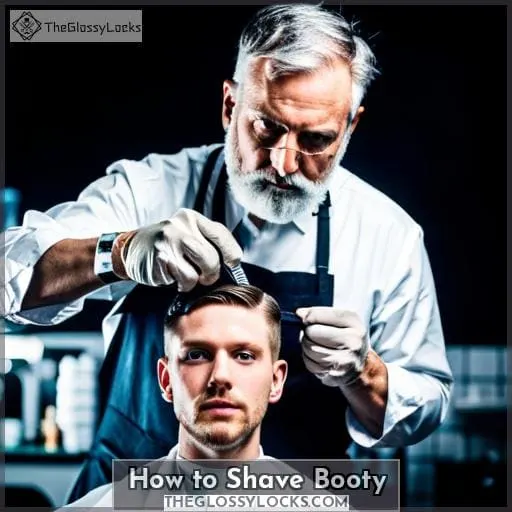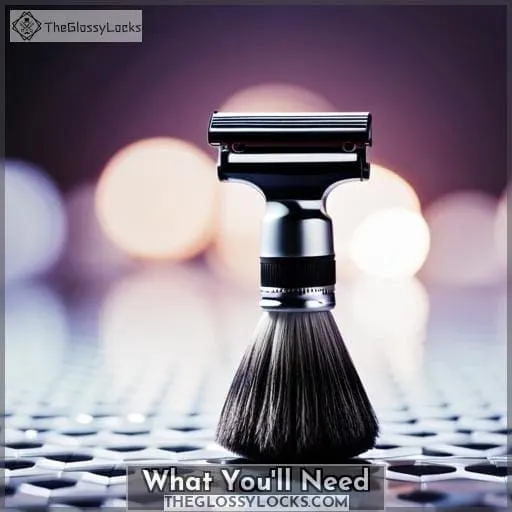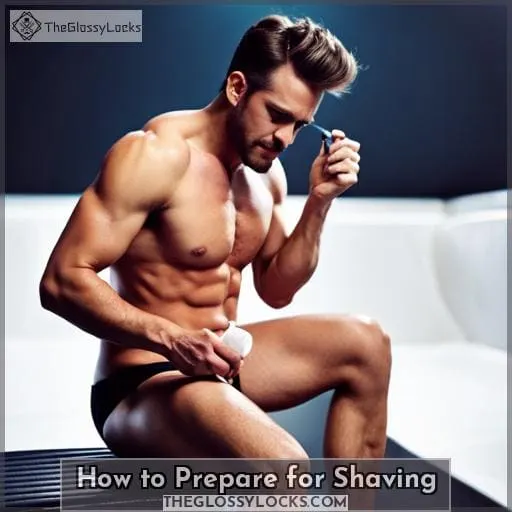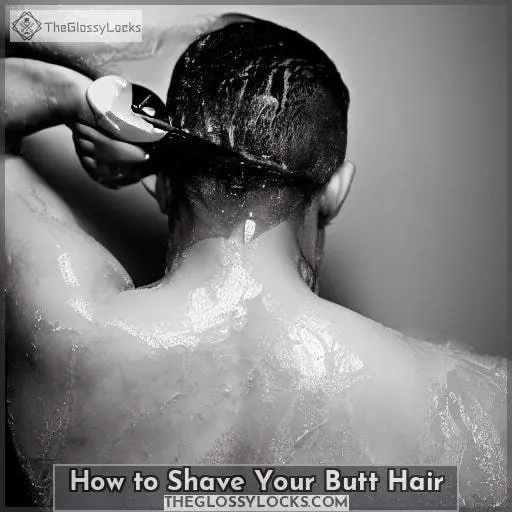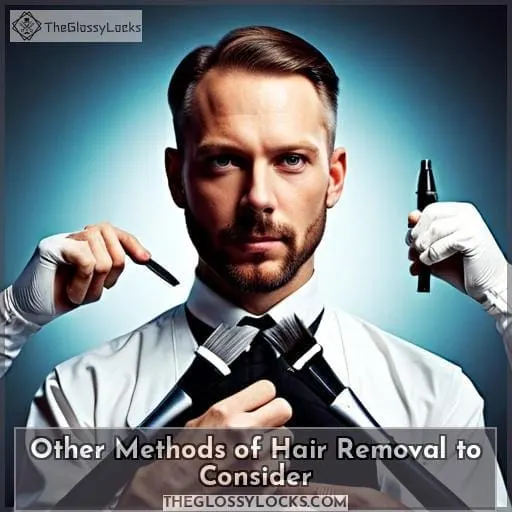This site is supported by our readers. We may earn a commission, at no cost to you, if you purchase through links.
Do you know the feeling of having a fuzzy peach? It’s like an itch that can’t be scratched—literally. But there is something you can do about it: shaving your butt hair! Don’t worry, removing those pesky hairs doesn’t have to be scary or complicated.
This ultimate guide will give you all the information on how to shave your booty safely and effectively so that all that’s left behind are silky smooth cheeks.
Table Of Contents
- Key Takeaways
- Is Shaving Your Butt Hair a Good Idea?
- What You’ll Need
- How to Prepare for Shaving
- How to Shave Your Butt Hair
- Other Methods of Hair Removal to Consider
- Aftercare
- Frequently Asked Questions (FAQs)
- What are the potential risks associated with shaving my butt hair?
- Is it necessary to use a special razor for shaving my butt hair?
- Is it necessary to consult a healthcare provider or dermatologist before shaving my butt hair?
- What is the best way to prevent ingrown hairs after shaving my butt hair?
- How often should I shave my butt hair for best results?
- Conclusion
Key Takeaways
- Proper hygiene and caution are necessary to avoid irritation, infection, and ingrown hairs when shaving the buttocks.
- Choosing the right razor with skin protection features and using natural shaving cream works best for a successful shave.
- Trimming longer hairs with a clipper before using the razor ensures smoother results.
- Applying aloe vera gel or lotion on the buttocks area after shaving helps prevent hair regrowth and soothes the skin.
Is Shaving Your Butt Hair a Good Idea?
Shaving your butt hair is a personal choice, but it’s important to understand the purpose and risks of doing so. Butt hair serves an evolutionary purpose as a protective lining between the cheeks; however, removing it can lead to irritation, infection, ingrown hairs, and other complications if proper hygiene and caution aren’t taken.
Understanding these points before you start will help minimize the risks associated with shaving your booty.
Purpose and Normalcy of Butt Hair
It’s important to remember that butt hair is a normal part of the body and serves an evolutionary purpose, so removing it is a personal choice. Temporary methods, such as waxing, depilatory creams, and bikini trimmers, are available for those looking to remove their butt hair.
However, some may want more permanent solutions, like laser or electrolysis treatments, which come with associated risks, such as irritation or infection.
Proper hygiene can help minimize these risks. Warm water and soap soften hairs for smoother shaving, while using cleansers with salicylic acid can prevent ingrown hairs and acne in this area. Consulting your healthcare provider or dermatologist before pursuing any kind of removal method is highly recommended.
Risks and Precautions
When it comes to removing butt hair, it is important to take extra caution due to the potential for contamination and infection. To minimize the risks of skin irritation, razor burn, folliculitis prevention, or ingrown hairs, proper hygiene practices like washing with mild soap and water before removal should be followed.
For more permanent solutions such as laser hair removal or electrolysis using a small electric current, there is an increased risk of burns which could be avoided by consulting Dr. Goldstein first. Hair removal creams are not recommended in this area either since they can cause further inflammation and discomfort on top of being ineffective in some cases.
To avoid any complications, you should always use sharp razors with a protective guard when shaving your butt region. Trimming longer hairs beforehand will ensure smooth results while also helping minimize itching after the procedure is done! Ultimately, whether to remove butt hair is all up to personal preference, but it’s important to keep safety at the forefront if you do choose to do so.
What You’ll Need
Shaving your butt is a personal choice, and it’s important to make sure you have the right supplies for the job. Choosing an appropriate razor that is designed for sensitive skin can help minimize irritation and other risks associated with shaving.
You might also want to pick up some shaving cream or gel, clippers for trimming longer hairs, a handheld mirror if needed, and aloe vera in case of bumps or irritation after removal.
Choosing the Right Razor
Choosing the right razor is essential for achieving a smooth and comfortable trim on your bottom. When selecting a razor, look for one with skin protection features, such as multiple blades or guards. For even closer shaves, consider using a bikini shaver that’s specifically designed to remove pubic hair in sensitive areas without irritating the delicate skin found there.
Be sure to apply shaving cream before you start and use warm water and mild soap during shaving to help soften butt hairs so they’re easier to manage.
Finally, always make sure your equipment is sharp and clean before starting. Dull razors can cause serious cuts or infections if not handled properly.
Other Supplies
Aside from a razor, you may need other supplies to get the perfect results when removing butt hair. Cleaning tips are important – make sure to wash the area with mild soap and water before shaving for extra protection against irritation.
Invest in a good quality razor that has multiple blades or skin guards to help reduce nicks and cuts.
For even closer shaves, consider using a bikini trimmer or laser hair removal system – both of which come with their own set of risks and benefits.
It is also recommended to explore with toys if you experience any kind of irritation after grooming so that you know how comfortable it will feel before engaging in butt stuff with others.
How to Prepare for Shaving
To prepare for shaving your buttocks, it is important to begin by cleaning the area with mild soap and water. Next, use clippers or scissors to trim any longer hairs so that they are short enough for the razor.
Finally, warm up in a shower or bath as this will help to soften butt hairs, making them easier to shave.
Cleaning the Area
Before shaving, make sure to properly clean the area with mild soap and warm water. This is an essential part of any hygiene routine when removing hair from the butt region. Depending on your skin and hair types, you may need to adjust your cleaning technique to ensure that all bacteria are removed before waxing or shaving at home.
A good wash can also help get rid of facial hairs and prevent ingrown hairs from forming after removal. It’s best to consult a board-certified dermatologist for advice on how often you should wash and what moisturizing routine works best for you if irritation occurs after removal procedures such as home waxing or laser treatments.
Taking proper care of your body is key when it comes to butt grooming. Make sure to follow hygiene habits to keep the area clean and healthy.
Trimming Longer Hair
Trim your longer hairs first with a clipper before using the razor to ensure smoother results. To get the best trimming technique, use a clipper that is designed for sensitive areas and has adjustable guard settings.
When it comes to choosing a razor type, Dr. Clay recommends looking for one that includes an aloe strip or built-in moisturizer bar as this can help reduce irritation and bumps after shaving.
Following proper hygiene tips like washing with mild soap and warm water prior to removal will also help minimize any potential risks of infection or ingrown hairs. Post-shave care should include applying aloe vera gel or lotion on the butt area every day until the skin heals completely from any cuts caused by shaving blades.
Furthermore, pulses of powerful laser beams are available at dermatologists’ offices if you prefer permanent hair removal solutions instead of temporary methods such as waxing or shaving for your butt hairs.
How to Shave Your Butt Hair
Once you’ve prepared your skin, it’s time to shave your butt hair. To do this safely and effectively, follow these steps:
Start by using a sharp razor with a skin guard or trimmer with a skin guard for precision. Apply shaving cream generously in the area to prevent irritation, and use a handheld mirror if necessary for accuracy.
For extra safety, spread the cheeks apart while shaving. This will allow you to focus on each spot more easily without cutting yourself or missing any hairs. Make sure that no part of the hole itself is shaved, as only trimming or shaving around it is recommended on both sides of the front and back areas.
Always go against the grain when possible to avoid ingrown hairs from forming later on.
Using laser therapy can also be an option if you’re looking for permanent results, but consulting a healthcare provider beforehand is necessary. Severe allergic reactions may occur due to laser treatment, depending on an individual’s sensitivity level towards the light beams used during the procedure.
So caution should be taken when considering such a method of hair removal. If opting for temporary methods instead, then bikini trimmers are a great choice since they provide gentle grooming without causing issues like cuts or nicks.
Salicylic acid cleansers can help unclog pores caused by follicle build-up, which could lead to the development of acne in the buttocks area.
Other Methods of Hair Removal to Consider
You’re likely considering other methods for hair removal on your booty, such as waxing, depilatory creams, laser hair removal, or electrolysis.
Waxing is a great option if you want to get rid of the hair in one go, and it can be done at home or professionally.
Depilatory creams are not recommended due to their potentially harsh ingredients that may irritate sensitive skin.
Laser hair removal and electrolysis are more permanent options, but they come with certain risks like burns and scarring. Consulting a healthcare provider first is necessary before proceeding with either method.
Waxing
Waxing can provide relatively long-lasting results and is a great option for those wanting to temporarily remove butt hair; just be sure to leave it to the professionals! At-home waxing increases the risks of infection, ingrown hairs, and irritation.
Professional waxers use high-quality products and techniques that minimize pain. The duration of treatment depends on pain threshold but typically lasts around 30 minutes.
| Waxing Benefits | Waxing Risks |
|---|---|
| Long-Lasting Results | Infection Risk with At-Home Wax Kits |
| Smooth Skin Texture | Ingrown Hairs |
| Minimizes Hair Growth Over Time | Irritation or Redness |
Dr. Evan Goldstein suggests starting with professional services before attempting at-home methods due to delicate areas in question. An anal surgeon consultation is recommended if experiencing complications from at-home treatments such as skin tags or abscesses.
Proper hygiene should also be maintained after the process by avoiding tight clothing or harsh soaps in the treated area while waiting for new follicles growth (usually within four weeks).
Depilatory Creams
Depilatory creams may seem like an easy option for hair removal, but they are not recommended in the nether regions due to potential risks of irritation and infection. When selecting a product, look out for small commissions that can help protect from skin damage.
Before use, proper hygiene should be taken into account as extra caution is required when applying the cream near sensitive areas. To prevent irritation, it is recommended to wait at least three days after special occasions before using depilatories again.
Since the desired result may vary with personal preference, it’s best to consult a healthcare provider or dermatologist beforehand.
Laser Hair Removal
If you’re looking for a more permanent solution, laser hair removal may be the way to go. It targets butt hair removal and can even reach delicate parts of the body with little pain. Laser treatments reduce hair growth while preventing potential complications such as skin irritation or infection due to their ability to kill bacteria at the root level.
Benefits include:
- Targets Butt Hair Removal
- Reduces Hair Growth
- Kills Bacteria at Root Level
Aftercare is key, so follow your doctor’s instructions carefully and take into account skin lines when shaving after treatment is complete.
Electrolysis
Electrolysis is a more permanent option to consider when it comes to hair removal. This procedure targets individual hairs with precision and can permanently remove them from the root. However, be warned that electrolysis may come with some risks such as skin irritation or infection, and severe side effects are possible if done incorrectly.
The cost of this technique could also be lofty, so make sure you consult an anal surgeon prior to attempting it on your own buttocks! Just remember that proper aftercare is key – shave at the end of your shower for best results.
Aftercare
After shaving your buttocks, it is important to take proper aftercare measures. Applying aloe vera or a soothing cream to the area can help prevent bumps and irritation. Additionally, waiting three to five days before engaging in sexual activity is recommended as this will give the skin time to heal any nicks that may have occurred during hair removal.
Lastly, using cleansers with salicylic acid can help keep ingrown hairs and butt acne at bay by preventing clogged follicles.
Aloe Vera and Other Soothing Methods
After removing butt hair, you can soothe the area with aloe vera or other natural methods to help minimize irritation. It’s important to keep the skin around your booty clean and dry after shaving for proper hygiene.
If you have a lot of hair, consider laser alternatives such as waxing or bikini trimming instead of using a razor. For longer hairs on your buttocks, use scissors instead of tweezers to avoid ingrowns near your butthole.
When shaving, be extra mindful of sensitive skin and take an OTC pain reliever if necessary afterwards. Always follow safety guidelines during the removal process and ensure all tools are thoroughly cleaned beforehand to protect yourself from any infection risks associated with butt hair removal.
Waiting Before Engaging in Sexual Activity
It’s important to wait at least 3-5 days before engaging in any butt stuff after experiencing irritation or nicks from hair removal methods. This allows time for the skin to heal and minimizes risks of getting an infection, ingrown hairs, or butt acne.
If you experience small cuts as a result of shaving in such a tight space with optimal body temperature and humidity levels that increase casual sex appeal, take extra caution! Body contortion is needed if wanting to shave right sides without missing spots, and spreading cheeks apart with one hand while using a razor with the other can cause trouble too!
Avoid further complications by waiting until your booty heals up before doing anything else down there.
Preventing Ingrown Hairs and Butt Acne
To prevent ingrown hairs and butt acne, use a cleanser with salicylic acid in your post-shave routine. This will help clear away any trapped bacteria and oils that may have clogged the hair follicles during shaving or waxing.
Additionally, it’s important to keep the area clean on a regular basis to avoid irritation and infection. Wearing loose-fitting clothing can provide further protection against bumps by allowing air circulation around your booty for faster healing time after removal of butt hair.
For those who experience lots of sweating in this region, consider using absorbent powder as part of their skincare regimen to keep things dry down there! If you’re looking for a less hairy type of primate, look no further; shaving is probably the best way (yet inconvenient option) to get a good look at the anus from different angles without experiencing troubleshooting bumps afterward due to safety tips mentioned above!
Frequently Asked Questions (FAQs)
What are the potential risks associated with shaving my butt hair?
Shaving butt hair can cause irritation, infection, ingrown hairs, and cuts. Therefore, it is essential to take extra care when removing hair around this delicate area.
Is it necessary to use a special razor for shaving my butt hair?
No, it is not necessary to use a special razor for your butt hair. However, using one designed for sensitive skin can help reduce irritation and minimize potential risks associated with shaving. Choose a sharp razor with a skin guard to ensure accuracy and safety when removing the hair from this delicate area.
Is it necessary to consult a healthcare provider or dermatologist before shaving my butt hair?
Consulting a healthcare provider or dermatologist before shaving your butt hair can be beneficial. They may provide advice to help prevent irritation, infection, and ingrown hairs.
What is the best way to prevent ingrown hairs after shaving my butt hair?
To avoid ingrown hairs, use a cleanser with salicylic acid daily and warm water and soap before shaving. Follow the skin lines carefully, shave with the grain to prevent irritation, and then apply aloe vera for soothing relief.
How often should I shave my butt hair for best results?
Shave your butt hair every 2-3 weeks to avoid irritation and ingrown hairs. Keep razors sharp, use shaving cream, and trim first if needed.
Conclusion
Shaving your butt hair is a personal choice and can be a good solution if done properly. With the right tools and technique, you can safely and effectively remove hair from your backside.
Just remember to be careful and follow the steps to minimize the risk of irritation, infection, and ingrown hairs. Imagining yourself with silky and smooth butt cheeks is a great way to motivate yourself to take the time to properly shave your butt.
With a little bit of practice and patience, you can achieve your desired results.

